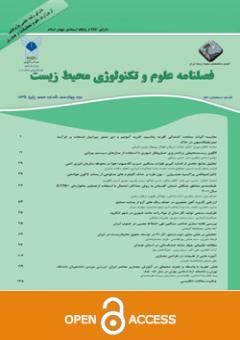Investigation of effective parameters on thermal efficiency in a porous channel under local thermal equilibrium conditions
Subject Areas : Renewable Energyzohreh poursharif 1 , Hesamoddin SALARIAN 2 , Kourosh Javaherdeh 3 , majid Eshagh Nimvari 4
1 - Department of Mechanical Engineering, Nour Branch, Islamic Azad University, Nour, Iran.
2 - Department of Mechanical Engineering, Nour Branch, Islamic Azad University, Nour, Iran. *(Corresponding Authors)
3 - Faculty of Mechanical Engineering, University of Guilan, Rasht, Iran.
4 - Faculty of Engineering, Amol University of Special Modern Technologies, Amol, Iran
Keywords: porous channel, Darcy number, non-Newtonian fluid, local thermal equilibrium.,
Abstract :
Background & Objective: By improving the performance of the heat exchanger, it is possible to reduce the size and production costs of the heat transfer, and this leads to a reduction in fuel consumption and better environmental protection. To this purpose, engineers have proposed several ways to increase the heat transfer. The heat transfer rate of a turbulent non-Newtonian fluid flow in a heat exchanger with partially porous media is numerically investigated in this paper. The effects of power-law index of the fluid and Darcy number on the heat transfer rate and thermal performance of turbulent flow are studied and compared to each other.
Material and Methodology: The research model is simulated in the FLUENT computational fluid dynamics software using Finite Volume Method and the flow and energy equations are discretized up to the second order upwind.
Findings: The pseudo-plastic fluid has the highest heat transfer rate and thermal performance compared to Newtonian and dilatant fluids. According to the findings, the heat transfer rate and thermal performance increase with decreasing Darcy number. Investigation of the effect of non-dimensional porous layer area (S) on the Nusselt number and thermal efficiency in different Darcy numbers shows that, the Nusselt number has the highest value in S=0.9 and thermal efficiency has the highest value in S=0.76.
Discussion and conclusion: S=0.76 is the optimal porous layer thickness. Therefore, porous layer with S=0.76, and the pseudo-plastic fluid are recommended for the optimal thermal efficiency.
1. Chen G, Hadim H. Forced convection of a power-law fluid in a porous channel–numerical solutions. Heat and Mass Transfer. 1998;34(2-3):221-8.
2. Yilmaz N, Bakhtiyarov AS, Ibragimov RN. Experimental investigation of Newtonian and non-Newtonian fluid flows in porous media. Mechanics Research Communications. 2009;36(5):638-41.
3. Huang Z, Nakayama A, Yang K, Yang C, Liu WJIJoH, Transfer M. Enhancing heat transfer in the core flow by using porous medium insert in a tube. 2010;53(5-6):1164-74.
4. Jamarani A, Maerefat M, Jouybari NF, Nimvari MEJTiPM. Thermal performance evaluation of a double-tube heat exchanger partially filled with porous media under turbulent flow regime. 2017;120(3):449-71.
5. Shirvan KM, Mirzakhanlari S, Kalogirou SA, Öztop HF, Mamourian MJIJoTS. Heat transfer and sensitivity analysis in a double pipe heat exchanger filled with porous medium. 2017;121:124-37.
6. Barnoon P, Toghraie DJPT. Numerical investigation of laminar flow and heat transfer of non-Newtonian nanofluid within a porous medium. 2018;325:78-91.
7. Mohebbi R, Delouei AA, Jamali A, Izadi M, Mohamad AA. Pore-scale simulation of non-Newtonian power-law fluid flow and forced convection in partially porous media: Thermal lattice Boltzmann method. Physica A: Statistical Mechanics and its Applications. 2019;525:642-56.
8. Baragh S, Shokouhmand H, Ajarostaghi SSM, Nikian M. An experimental investigation on forced convection heat transfer of single-phase flow in a channel with different arrangements of porous media. International Journal of Thermal Sciences. 2018;134:370-9.
9. Syed KS, Ishaq M, Bakhsh MJC, Fluids. Laminar convection in the annulus of a double-pipe with triangular fins. 2011;44(1):43-55.
10. Antohe B, Lage JJIJoH, Transfer M. A general two-equation macroscopic turbulence model for incompressible flow in porous media. 1997;40(13):3013-24.
11. Pedras MH, de Lemos MJJIjoh, transfer m. Macroscopic turbulence modeling for incompressible flow through undeformable porous media. 2001;44(6):1081-93.
12. Nakayama A, Kuwahara FJJofe. A macroscopic turbulence model for flow in a porous medium. 1999; 121(2):427-33.
13. Nazari M, Mohebbi R, Kayhani M. Power-law fluid flow and heat transfer in a channel with a built-in porous square cylinder: Lattice Boltzmann simulation. Journal of non-Newtonian fluid mechanics. 2014;204:38-49.
14. Silva RA, de Lemos MJ. Turbulent flow in a channel occupied by a porous layer considering the stress jump at the interface. International Journal of Heat and Mass Transfer. 2003; 46(26):5113-21.
15. Nield DJIJoH, Flow F. The limitations of the Brinkman-Forchheimer equation in modeling flow in a saturated porous medium and at an interface. 1991;12(3):269-72.
16. Nasiri M, Etemad SG, Bagheri RJICiH, Transfer M. Experimental heat transfer of nanofluid through an annular duct. 2011;38(7):958-63.
17. Prasad KV, Santhi SR, Datti PS. Non-Newtonian power-law fluid flow and heat transfer over a non-linearly stretching surface. Applied Mathematics. 2012; 3(5):425-35.
18. Nebbali R, Bouhadef KJIjots. Non-Newtonian fluid flow in plane channels: Heat transfer enhancement using porous blocks. 2011; 50(10):1984-95.
19. Shenoy AJAiHt. Non-Newtonian fluid heat transfer in porous media. 1994; 24:102-91.
20. Heydari M, Toghraie D, Akbari OAJTS, Progress E. The effect of semi-attached and offset mid-truncated ribs and Water/TiO2 nanofluid on flow and heat transfer properties in a triangular microchannel. 2017;2:140-50.
21. Rabbani P, Hamzehpour A, Ashjaee M, Najafi M, Houshfar EJPT. Experimental investigation on heat transfer of MgO nanofluid in tubes partially filled with metal foam. 2019; 354:734-42.


